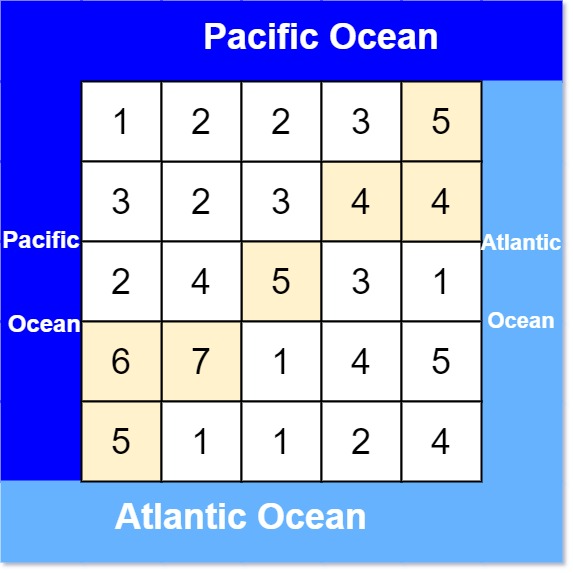有一个 m × n 的矩形岛屿,与 太平洋 和 大西洋 相邻。 “太平洋” 处于大陆的左边界和上边界,而 “大西洋” 处于大陆的右边界和下边界。
这个岛被分割成一个由若干方形单元格组成的网格。给定一个 m x n 的整数矩阵 heights , heights[r][c] 表示坐标 (r, c) 上单元格 高于海平面的高度 。
岛上雨水较多,如果相邻单元格的高度 小于或等于 当前单元格的高度,雨水可以直接向北、南、东、西流向相邻单元格。水可以从海洋附近的任何单元格流入海洋。
返回 网格坐标 result 的 2D列表 ,其中 result[i] = [ri, ci] 表示雨水可以从单元格 (ri, ci) 流向 太平洋和大西洋 。
示例 1:
输入: heights = [[1,2,2,3,5],[3,2,3,4,4],[2,4,5,3,1],[6,7,1,4,5],[5,1,1,2,4]]
输出: [[0,4],[1,3],[1,4],[2,2],[3,0],[3,1],[4,0]]
示例 2:
输入: heights = [[2,1],[1,2]]
输出: [[0,0],[0,1],[1,0],[1,1]]
提示:
m == heights.length
n == heights[r].length
1 <= m, n <= 200
0 <= heights[r][c] <= 105
class Solution {/**分别从左,上边界来标记能到哪,再从右,下边界来标记能到哪,求都能到的地方*/public List<List<Integer>> pacificAtlantic(int[][] heights) {int n = heights.length, m = heights[0].length;boolean[][] st1 = new boolean[n][m], st2 = new boolean[n][m];List<List<Integer>> res = new ArrayList<>();Deque<int[]> q = new LinkedList<>();int[] dirs = new int[]{-1, 0, 1, 0, -1};for (int i = 0; i < n; ++i) {q.addLast(new int[]{i, 0});st1[i][0] = true;}for (int i = 0; i < m; ++i) {q.addLast(new int[]{0, i});st1[0][i] = true;}while (!q.isEmpty()) {int[] t = q.pollLast();for (int i = 0; i < 4; ++i) {int x = t[0] + dirs[i], y = t[1] + dirs[i + 1];if (x < 0 || x >= n || y < 0 || y >= m) continue;if (st1[x][y]) continue;if (heights[x][y] >= heights[t[0]][t[1]]) {q.addLast(new int[]{x, y});st1[x][y] = true;}}}for (int i = 0; i < n; ++i) {q.addLast(new int[]{i, m - 1});st2[i][m - 1] = true;}for (int i = 0; i < m; ++i) {q.addLast(new int[]{n - 1, i});st2[n - 1][i] = true;}while (!q.isEmpty()) {int[] t = q.pollLast();for (int i = 0; i < 4; ++i) {int x = t[0] + dirs[i], y = t[1] + dirs[i + 1];if (x < 0 || x >= n || y < 0 || y >= m) continue;if (st2[x][y]) continue;if (heights[x][y] >= heights[t[0]][t[1]]) {q.addLast(new int[]{x, y});st2[x][y] = true;}}}for (int i = 0; i < n; ++i)for (int j = 0; j < m; ++j)if (st1[i][j] && st2[i][j]) {List<Integer> list = new ArrayList<>();list.add(i);list.add(j);res.add(new ArrayList<>(list));}return res;}}
dfs
class Solution {/**dfs*/int[][] h;boolean[][] st1, st2;int n, m;int[] dirs = new int[]{-1, 0, 1, 0, -1};public List<List<Integer>> pacificAtlantic(int[][] heights) {h = heights;n = heights.length; m = heights[0].length;st1 = new boolean[n][m]; st2 = new boolean[n][m];for (int i = 0; i < n; ++i) {st1[i][0] = true;dfs(i, 0, st1);}for (int i = 0; i < m; ++i) {st1[0][i] = true;dfs(0, i, st1);}for (int i = 0; i < n; ++i) {st2[i][m - 1] = true;dfs(i, m - 1, st2);}for (int i = 0; i < m; ++i) {st2[n - 1][i] = true;dfs(n - 1, i, st2);}List<List<Integer>> res = new ArrayList<>();for (int i = 0; i < n; ++i)for (int j = 0; j < m; ++j)if (st1[i][j] && st2[i][j]) {List<Integer> list = new ArrayList<>();list.add(i); list.add(j);res.add(new ArrayList<>(list));}return res;}void dfs(int x, int y, boolean[][] st) {for (int i = 0; i < 4; ++i) {int a = x + dirs[i], b = y + dirs[i + 1];if (a < 0 || a >= n || b < 0 || b >= m) continue;if (st[a][b]) continue;if (h[a][b] < h[x][y]) continue;st[a][b] = true;dfs(a, b, st);}}}

